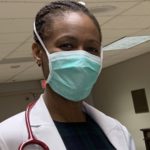 In our lifetimes, most of us have probably never experienced a situation as rapidly evolving as COVID-19.
In our lifetimes, most of us have probably never experienced a situation as rapidly evolving as COVID-19.
For almost 3 weeks now, most healthcare settings have adopted the policy of universal wearing of masks.
More recently, CDC recommended “cloth face coverings in public settings where other social distancing measures are difficult to maintain (example in grocery stores and pharmacies), especially in areas of significant community-based transmission.”
Are masks the be all and end all of COVID19 prevention though?
No. And I think that is why the CDC was hesitant to recommend masking for the public earlier on. Along with the fact that there has been a severe shortage, and they did not want a situation where there were no surgical masks for the people who needed them the most – healthcare workers.
Why are masks not the be all and end all of COVID19 prevention?
– The most important aspect of COVID19 prevention, is avoiding contact with potentially infected persons. Hence physical, or social, distancing (minimum 6 feet) if you have to leave the bubble of your house. You can’t get infected if you are not in (close) contact with a source of infection.
– Second and equally important pillar of COVID19 prevention is hand washing. Because an infected person may cough on a surface, or touch a surface with contaminated hands that he/she coughed on, you can then come along and touch that contaminated surface, and then touch your nose, mouth or eyes. You are now inoculated with the virus and can go on to get infection.
The fact is that we all touch our faces unconsciously. If we are in the habit of frequently washing our hands, or sanitizing with at least 60% alcohol based hand sanitizer when not able to wash, we are much less likely to get infected.
We know Coronavirus can stay alive on surfaces, including our hands, for many hours. Cleaning our hands frequently when out and about keeps the concentration of virus on them minimal to zero.
Now to masks. Surgical masks definitely offer protection to healthcare workers. The level of protection will vary depending on how well the mask is worn. A mask snugly fitted aver the nose and mouth is much better than a loosely fitting mask, or worst, a mask that is over the mouth only, or heaven forbid, on the chin!
Cloth face coverings on the other hand, are for source control; they prevent the wearer from spreading infection. Per the CDC, it is uncertain whether cloth face coverings protect the wearer.
Bottom line is, there could possibly be some protection to the wearer of a cloth face covering. However wearing a cloth face covering WITHOUT frequently cleaning the hands will likely do nothing to prevent you from getting COVID19.
Likewise, wearing a cloth face covering but being in crowded environments where there are potentially persons with active COVID19, will not do much to prevent you getting infected.
CONCLUSION
The highest risk for SARS-CoV-2 infection is prolonged close contact with an infected person who coughs, sneezes, or speaks. Airborne transmission over long distances is unlikely.
The best way to prevent COVID19 is to avoid being exposed. Per CDC, “the cloth face cover is not a substitute for social distancing.”
However, if everyone wears a face covering, there is better containment of the virus in those infected, and much less risk of continued spread of this sneaky disease. Then maybe we can all get back on with life, although it will probably never be the same again.
Take care of yourselves everyone!
Leave a Reply